Carbonates-Reefs
- Page ID
- 10865

https://en.Wikipedia.org/wiki/File:Coral_Outcrop_Flynn_Reef.jpg
Figure 0: The image above shows a healthy, colorful coral reef. The color is due to the symbiotic relationship with zooxanthellae algae, which produce color pigments. Corals need warm, clear water (without sediments).
Introduction:
Reefs consists of corals and other organisms made of calcium carbonate and are home to many colorful fishes. Coral reefs have a wide variety of calcareous corals that ultimately get broken up into fragments through physical weathering, which are then deposited helping to create the magnificent reefs you see. The most common type of coral today is the Scleractinia. Coral reefs are the rainforest of the sea with great diversity, but are highly threatened due to climate change and human impact. Corals have slow growth rates and can take thousands of years to grow and regrow if disturbed. Waves, or the water movement along fish such as Parrot Fish help break down carbonate shells and corals forming sand on bottom. Parrot fish help the coral reefs stay clean and eat up dead coral. Corals and calcium carbonate forms when carbonate (CaCo3) is absorbed from ions in the ocean when the water temperature are right, and there is movement which removes carbon dioxide. Biological conditions are the most dominant factor in making carbonates for reefs. Reefs form when free swimming coral larvae attach to rocks, and other submerged hard surfaces developing into polyps and maturely formed coral. Corals reproduce in a few ways either through internal or external fertilization through spawning in the water. Organisms produce carbonate skeletons from the ions in the water. There are calcareous snails and echinoderms. Calcareous organisms such as mollusks and brachiopods contribute to carbonate build up. Furthermore, when they get broken down they form the crushed coral sand which is habitat to other organisms. Aragonite is similar to carbonate and is also be found in reefs. Carbonate reefs usually form in shallow, warm, clear marine environments. Corals and biogenic carbonate production generally occurs in the photic one which is up to 100 meters in water depth. (Nichols, 2009). The top 10 meters is where most of the calcareous organisms are located due to the availability of sunlight and is known as the carbonate factory.
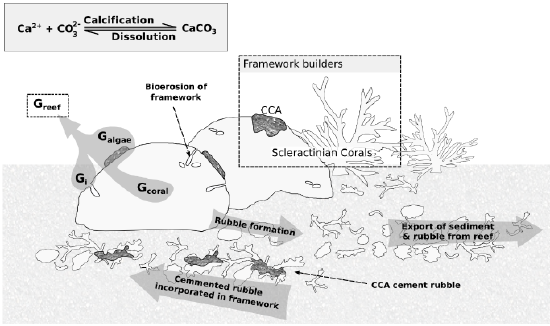
Figure 1: This image shows the process of forming Calcium Carbonate and some of the main reef building organisms.
Carbonate rocks do not require transportation of sediments and form from seawater ions. The specific chemical, biological, and temperature conditions that are present determine the amount of carbonate production. Carbonates are made by living organisms in which calcium carbonate makes up the organism’s shell and skeleton. Calcite and aragonite are polymorphs that are the two main types of calcium carbonate made by organisms. The reaction is Ca 2++ Co32- to CaCo3 which can either go in the forward or backwards direction. Calcifying algae with its high abundance produce carbonate mud/sand grains which accumulate over time. When the algae die they get broken down and transported through the ocean currents. The Hjulstrom diagram is followed as other organisms and calcium carbonate sediments get transported. Coarser grains require higher flow speeds while smaller grains require lower flow speeds. Corals are another main calcium carbonate organism that form reefs. Corals are usually in well lit, clear water so that the zooxanthellae algae can undergo photosynthesis. The algae provides nutrients and the color to corals. Corals have robust skeletons and can withstand the moving waves. Wave motion increases the amount of calcium carbonate formation. Over times reefs grow upward creating steep, unstable slopes which can lead to turbidites.
Where are Coral reefs located?
Coral reefs are located next to the Tropics where there is warm, shallow, clear water. Reefs are found near the equator between 25 degrees North and South of the Equator. Reefs do not have much clastic material coming in, and if there was too many sediments floating in the water sunlight for the reef would be blocked. There are a few main coral reefs such as the Great Barrier Reef in Australia, in the Bahamas, Florida, and Hawaii.
Facies and Structure of Reefs:
Reefs are divided by many sub-environments including the fore reef and the back reef (Nichols, 2009). The fore reef is the seaward side of a reef and is the deepest. In the fore reef there is rudstone and grain stone facies. The Dunham carbonate classification will be discussed later on. The back reef is the sheltered area towards the lagoon and is the site of deposition. There is also the reef crest where robust corals are located in order to withstand waves. Going down the reef front towards the deeper ocean there are more delicate and branching corals since it is lower energy deep water. Behind the reef crest is the reef flat where robust forms are also present but as you go down towards the lagoon more globular forms are present (Nichols, 2009). In the reef front there is a mixture of bafflestone, bindstone and framestone corals.
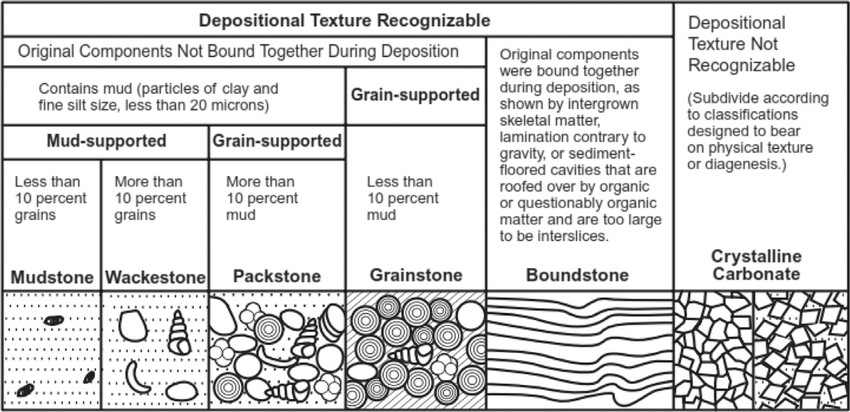
Figure 1.5 and 1.75: The Dunhams Classification Chart and the facies of coral reefs.
https://www.researchgate.net/figure/Dunhams-classification-of-carbonate-rocks_fig2_297736311
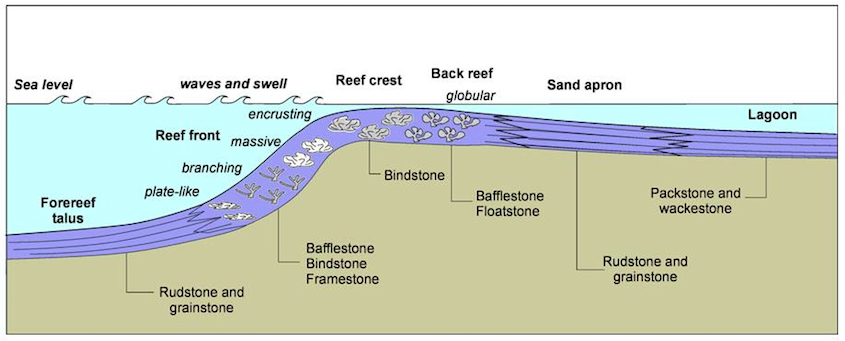
The main types of Reefs:
There are three main type of reefs including fringing reefs, barrier reefs, and atolls. (Nichols, 2009) These reefs are created by the movement of waves, submersion, and deposition over time. Barrier reefs include the Great Barrier Reef of Australia, Heron Island and Lady Elliot Island. Over time the reef type can change and a main distinguishing factor is the type of lagoon that forms around the reef. Other more specific and special reefs include apron, patch, ribbon and bank reefs.
Fringing Reefs: Fringing reefs are built right next to the shoreline and do not have a specific back reef lagoon area which distinguishes them from atolls and barrier reefs. Fringing reefs can form around volcanic islands. They can sometimes be hard to distinguish from a Barrier reef if it appears to have lagoon. The two main constituents of fringing and other types of reefs are the back reef and fore reef. The back reef is the shoreward and flat part of the reef. The reef slope is seaward of the beach and is steep and descending. The reef slope is where most of the corals grow due to less sediments and pollution accumulating. Specifically, corals grow the most profusely on the reef crest. Fringing reefs propagate from the shoreline, so the reef flat will go right to the beach and there will be no back reef in some fringing reefs. The Ningaloo Reef in Australia is one of many great examples of a Fringing Reef.
Barrier Reefs: Barrier reefs form parallel to the shoreline many kilometers away from the shore. Barrier reefs are separated by the land with the ocean. These reefs have a shallow, low energy back reef lagoon which is a site of deposition. The Great Barrier Reef in Australia is the largest Barrier reef which can even be seem from outer space made up of nearly 3,000 individual reefs. Coral polyps makes up a majority of this reef. This reef has human restrictions to protect it and is threatened by runoff from agriculture and sewage runoff.
Atolls: Atolls are ring shaped coral reefs that surround a lagoon. Atolls form from submerged volcanic islands/seamounts.(Atoll, 2012) As the underwater volcano erupts the lava is piled up on the seafloor. The elevation increases as the volcano continues to erupt and it surfaces to the water forming an oceanic island. Over time corals (Hermatypic corals) build a reef around the island. A fringing reef is now created. The volcanic seamounts erode due to waves from the ocean, gets eroded and sinks. On the top there is a smooth flat seamount called a guyot due to the waves smoothing the top off. Atolls have a lagoon in the center due to erosion and over flooding of the eroded volcano. Over time a barrier reef forms which is further out to sea with a protected lagoon. A subsidence event occurs due to crashing waves which causes the ocean chemistry to change. Seaward the reef is healthy while towards the lagoon side the reef decays. The waves then break the weak material and sand and other crushed material build up forming Atolls. Atolls are fragile and can be eroded easily.
The image below shows the formation of an atoll. The first stage is a volcanic island, followed by a fringing reef, then a barrier reef and finally an atoll.
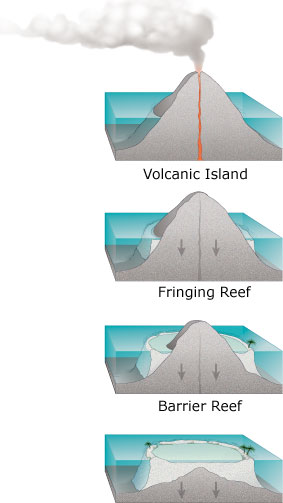
Figure 2: Shows Darwin's Subsidence Theory in forming an Atoll.
https://commons.wikimedia.org/wiki/File:Atoll_forming.jpg
Darwin’s Subsidence Theory: Darwin's Subsidence theory says how the different types of reefs are just the certain stages in reef development. Reefs can be converted into different types of reefs through time. Darwin proposed this theory when he was on his voyage of the Beagle. He proposed Fringing reefs get converted to Barrier reefs as a volcano subsides and vertical growth occurs. As the volcano subsides more and the corals grow up forming an atoll. There is still debate about this theory and if its 100% accurate. For instance, John Murray a scientists who did deep dives in his Challenger missions believes reefs form when dead corals dissolve and get washed out forming an atoll.(Woodroffe, 2011).
Lagoons: Lagoons are shallow bodies of water with limited connection to larger bodies of water( open ocean) usually through a barrier, or reef (Nichols, 2009). Lagoons are protected from open ocean waves. Ripples get formed in the shallow part of a lagoon from waves. Lagoons can either have a higher or lower salinity depending on the amount of rainfall. Lagoons form adjacent to reefs, specifically Barrier reefs. Atolls have a lagoon in the center as the volcanic island sinks and the corals grow up in a ring form. In barrier reefs the lagoon lies seaward between the shore and barrier reef. Lagoons are the main feature that determines the type of reef. Fringing reefs have no lagoons which distinguishes them from barrier reefs and Atolls.
Figure 3: The image below is of the Great Barrier reef in Australia.
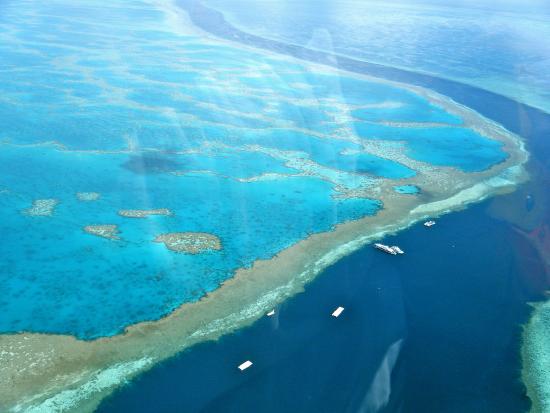
Figure 4: The three main types of coral reefs and their features.
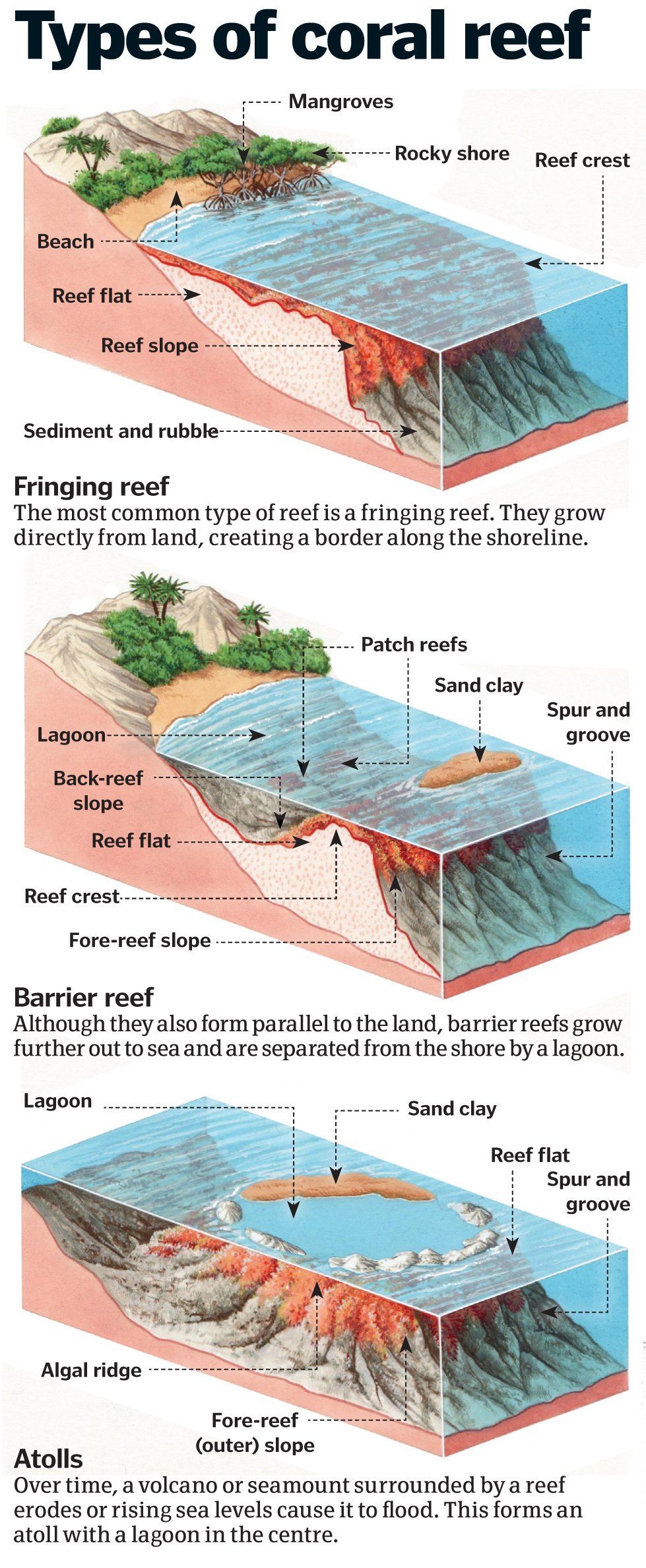
Source:
https://www.pinterest.co.uk/pin/452963675006130472/
The image above shows the main features of reefs such as a lagoon, reef flat, back reef and reef crest.
Carbonate Making and Sedimentation Processes:
Reef Growth conditions /Process:
Coral polyps require warm, clear, shallow and light sea water. Corals thrive where there is little sedimentation and mud getting transported from a river. Mud would block the sunlight and cause the coral polyps to die. Coral polyps excrete a calcareous substance and makes a hard skeleton of calcium carbonate. Over the years the corals grow upward, growing on top of existing dead polyps and also expand outward. Corals can even grow many meters down in darkness.
Biological, Physical (breaking up of shells), Chemical (ions)
Biological: Organisms
The majority of carbonate material is produced biogenically. Organisms produce hard skeletons/shells using carbonate ions in seawater. Carbonate producing organisms include mollusks, bivalves, gastropods, cephalopods, belemnites, brachiopods, barnacles, echinoderms, crinoids, and stromatorporoids (extinct sea sponges, that were important reef formers in the Paleozoic). The image below shows a Crinoid, or sea lily which forms several plates of calcium carbonate. These organisms are made of calcium carbonate and when they die they get broken down. If they end up below a certain depth they will dissolve and add ions to the water. The area where this occurs is below the lysocline which is about 750-4,300 meters for calcite (SEPM, 2013).
There are also plants and algae that produce carbonate. Biogenic carbonate is made from 3 main types of algae that settle and get broken down over time into calcium carbonate mud. The 3 main types of biogenic carbonate algae are Red algae (Rhodophyta), Green algae (Chlorophyta), and Yellow algae (Chrysophyta/Coccoliths) (Nichols,2009). There are also cyanobacteria including Stromatolites, oncoids that later form carbonate mud. Stromatolites, or layered calcareous mounds are produced by cyanobacteria. Sediment gets trapped and the cyanobacteria secrete lime. Finally, peloids and other bioclasts form carbonate mud.
Chemical: Ocean Chemistry and Carbonate Process
The chemical carbonate process as explained earlier is when chemical ions in seawater are used to make calcium carbonate. The reaction is Ca 2++ Co32- to CaCo3 which can either go in the forward or backwards direction. Chemical processes usually involve bubbling and change of color and material. Carbon dioxide is used to help change carbonate ions in the ocean. The ocean chemistry, water depth, and biology affect the type of carbonate formed. An increase in surface area will increase the amount of chemical change and processes that occur.
Physical:
The physical process on reefs is accompanied with waves, bio-erosion and storms. In general physical weathering is the break down of material into smaller pieces without chemical change. However, as the material is broken down the surface area increases and it will be more susceptible to chemical weathering. Organisms break down broken up shells and turn them into sand. Storms break apart corals and bio-eroders, or the waves break up the pieces. In the physical process no new mineral is made and the original material is the same. The water depth and the waves determines the amount the carbonates will get broken down. Also, the thickness of the coral determines how quickly the coral can be broken down.
The image below is of a Crinoid, a calcium carbonate producing organism.
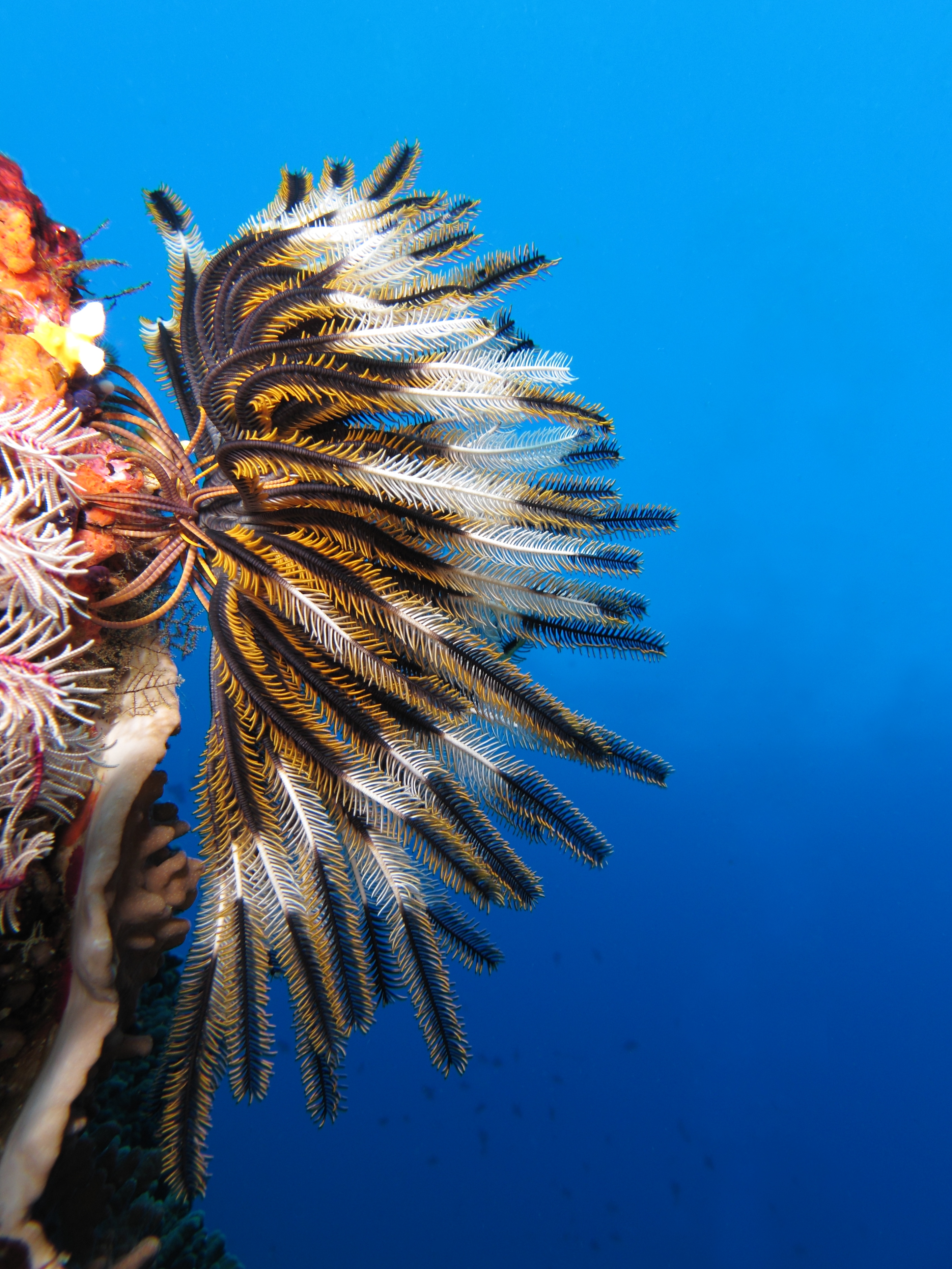
Figure 5: A Crinoid, or Sea Lily that forms calcium carbonate biologically.
https://upload.wikimedia.org/Wikipedia/commons/d/d2/Crinoid_on_the_reef_of_Batu_Moncho_Island.JPG
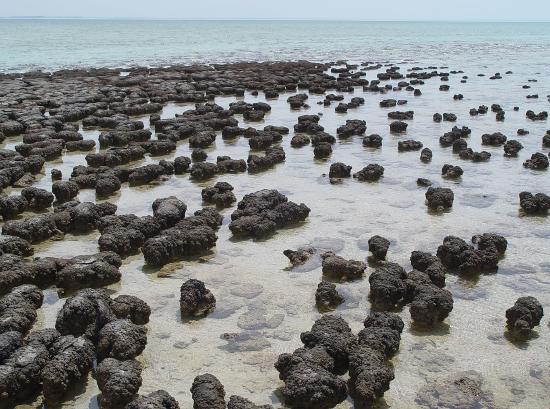
https://commons.wikimedia.org/wiki/File:Stromatolites_in_Sharkbay.jpg
Figure 6: The image above shows stromatolites in Shark Bay, West Australia which formed layers of carbonate produced by cyanobacteria.
Carbonates/Reefs in General:
In general when classifying carbonate and limestone rocks the Dunham Classification is used (Nichols, 2009). This classification classifies carbonate rocks based on the type of carbonate, texture, and what holds the grains together, or the support. The proportion of carbonate mud, and the framework of the rock are analyzed. (Nichols, 2009) First the rock is examined to determine if the rock has a matrix, or clasts framework. Second the nature of the grains and framework material makes up the second criteria for the classification. With this the carbonate is described as either a carbonate mudstone, wackestone, or boundstone (organic framework of coral colony) and many other specific names. Boundstone can be classified into bafflestone, bindstone and framestone (Nichols, 2009). These are all different types of carbonates.
Carbonate rocks are mostly form from the accumulation of calcareous organisms and are found in areas of high biological activity such as shallow ocean water. There is little siliclastic input in reefs and many carbonate rocks contain fossils/broken shell fragments. These carbonate rocks from reefs are used by sedimentologist to help construct the past geological events. Reef carbonates contain a good amount of hydrocarbons. Carbonates can form in many different types of depositional settings including basin and slope, reefs, and carbonate platforms. Carbonate platforms occur when there is a low input of detritus and clastic supply with shallow marine water. There are many types of carbonate platforms including ramp, rimmed and isolated platforms (Nichols, 2009). There are 3 main morphologies including carbonate banks and shelves. An example of a carbonate bank is a carbonate atoll. The types of grains present in the different platforms have changed over time due to the difference in abundances or calcareous organisms. For instance, in the Precambrian the main reef constituents were stromatolites, and in the Permian the large constituents were algae, sponges and corals. (Nichols figure 15.10, 2009)
Coral reefs depositional environment usually can occur on platform margins. Platform margins are areas with strong waves and tidal current energy. Carbonates that form reefs where there is a break in slope on the sea floor. Barrier reefs have discontinuous thin beds of sediment. Major components of platform margins include reef frames, reef apron, back reefs, fore reefs, and barrier islands (Harris, 2009). The reef frame consists of in-situ calcareous organisms mixed with silt, mud and calcareous sand. The calcareous sand, silt and mud form from bioerosion and occasional storms. The next component the reef apron usually consists of silt and larger debris that came from the reef frame. The reef apron has cross bedding (Harris, 2009). The back reef is made of sheets of burrowed mud with laminated carbonates and skeletal pieces from the reef crest. The grain size is sand to mud. Sand shoals would form if reefs end up not forming in a platform margin.
Degradation of Coral reefs:
Ocean acidification and climate change is a major threat to coral reefs. Coral bleaching and global warming are becoming more prevalent in coral reefs (Poloczanska, 2017). Due to the increasing sea temperature and acidity the zooxanthellae algae are unable to thrive, dying causing the coral to lose its color. Warm water reefs are shifting to higher latitudes since the ocean temperature is increasing (Poloczanska, 2017). Without the algae the corals are prone to dissolving, have less nutrients, and later bleach adding ions to ocean. Furthermore, corals and calcareous organisms must excrete enough calcium carbonate so they have strong skeletons to avoid bio-erosion and the waves. Fossil fuels and the increase in carbon dioxide is the main cause of coral bleaching due to the greenhouse effect. Carbon dioxide is absorbed by the ocean which is acidic while calcium carbonate is a base. Carbonic acid is formed and hydrogen ions are released. The hydroen ions combine with carbonate ions forming bicarbonate, removing carbonate that is needed for organisms to calcify. The two (carbon dioxide and calcium carbonate) react to neutralize each other and dissolving the coral. Other calcium carbonate organisms will not be able to form their shells since there will be less calcium ions and they will dissolve with the carbon dioxide. Coral reef fish will lose their habitat and have to move, or face dying. Another threat to coral reefs is tourism. Tourists break apart the corals to later sell, or keep them for their own interest. In addition fisherman are a threat. When fisherman trawl against the ocean floor they will break apart corals, destroying what took thousands of years to produce. Coral reefs could be eliminated between 2040-2050 (Poloczanska, 2017).
Figure 7&8: Show the processes of ocean acidification. These are different representations of ocean acidification.
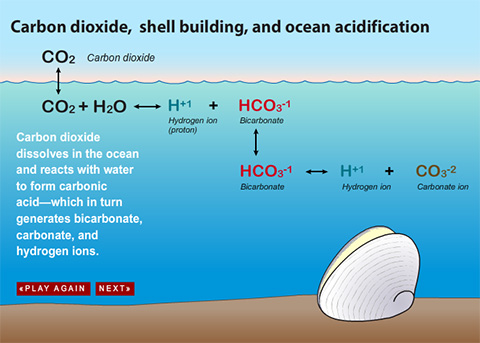
https://education.ocean.org/oceanlitlib/assignments/1114405
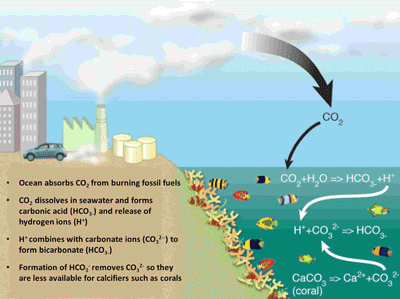
https://reefresilience.org/stressors/ocean-acidification/ocean-carbon-chemistry/
Summary:
Overall, reefs are fragile ecosystems and are degrading due to climate change and ocean acidification. Coral reefs may be gone by 2050 if action is not done. Calcium carbonate is formed from CaCO3 and Ca. The three main types of reefs are fringe, barrier and atolls. There are other more special reefs within these including pinnacle reefs. Due to Darwin’s Subsidence Theory the different types of reefs form from each other. Biological processes are the greatest constituent in reef building. Chemical and physical weathering are other processes that form, and create reefs. Dead calcareous organisms get broken down into sand and other particles. Ions in the water are used by organisms to secrete their carbonate. There are many different organisms and algae that secrete calcium carbonate. When the organisms die they get broken down and add to the reefs carbonate. The main structure of a reef includes a back and fore reef. Different facies make up the fore and back reef. The fore reef is the part that extends to the open ocean while the back reef extends to the lagoon and is where most of the deposition takes place.
Figure 9: The image below is of a bleached coral due to the loss of its symbiotic algae.
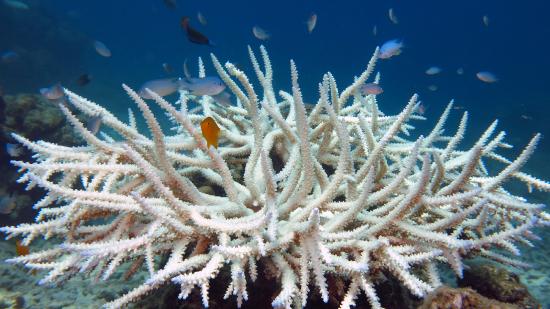
https://en.m.Wikipedia.org/wiki/File:Bleached_coral,_Acoropora_sp.jpg
Key Words:
Carbonates (Calcium Carbonate)
Reef Types (Fringing, Barrier, Atoll)
Dunham's Carbonate Classification
Fore Reef
Back Reef
Stromatolites
zooxanthellae algae
Darwin's Subsidence Theory
Lagoon
Ocean Acidification
Works Cited
3 Types Of Coral Reefs You Should Know About | ReefCI. https://reefci.com/2019/02/14/four-types-of-coral-reefs-you-should-know-about/. 2019 Accessed 6 June 2020.
Atoll | National Geographic Society. https://www.nationalgeographic.org/encyclopedia/atoll/. 2012 Accessed 6 June 2020.
Carbonate Facies - SEPM Strata. http://www.sepmstrata.org/page.aspx?&pageid=90&6. May 2013 Accessed 6 June 2020.
Carbonates Rocks. http://www.geosci.usyd.edu.au/users/prey/FieldTrips/Yass04/Carbonates.html. Accessed 6 June 2020.
Nichols, Gary. (2009). Sedimentology and stratigraphy (2nd ed.). Chichester, UK ; Hoboken, NJ: Wiley-Blackwell.
Harris, Paul M. Depositional Environments of Carbonate Platforms. pages. 31.
James, Noel. Reef Environment Carbonate Depositional Environments, GeoScienceWorld Books GeoScienceWorld. https://pubs.geoscienceworld.org/books/book/1422/chapter/107173417/Reef-Environment. Accessed 6 June 2020.
Poloczanska, Elvira, et al. Frontiers | Coral Reef Ecosystems under Climate Change and Ocean Acidification | Marine Science. May 2017, https://www.frontiersin.org/articles/10.3389/fmars.2017.00158/full.
Sumner, Dawn. “1.13: 14. Carbonates.” Geosciences LibreTexts, Libretexts, 3 June 2019, geo.libretexts.org/Courses/University_of_California_Davis/UCD_GEL_109%3A_Sediments_and_Strata_(Sumner)/01%3A_Lecture_Notes/1.13%3A_14._Carbonates.
Woodroffe, Colin. Subsidence Hypothesis of Reef Development | SpringerLink. Book 2011 Accessed 6 June 2020.

